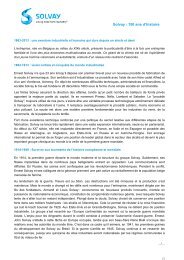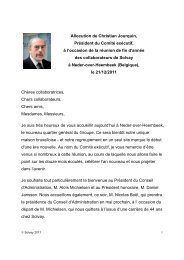THE FUTURE, - Solvay
THE FUTURE, - Solvay
THE FUTURE, - Solvay
Create successful ePaper yourself
Turn your PDF publications into a flip-book with our unique Google optimized e-Paper software.
Performance<br />
improvement<br />
32<br />
Performance improvement > INNOVATIONS 09<br />
208397 208588 208983<br />
COMBINED CYCLE POWER PLANT AT BAHIA<br />
BLANCA<br />
Solalban Energía:<br />
energy security in a volatile<br />
market<br />
<strong>THE</strong> PROJECT. In a context of uncertainty<br />
as to the availability and price of electricity,<br />
it was time for <strong>Solvay</strong> Indupa to take an important<br />
step in Argentina: building a power plant<br />
capable of ensuring the energy self-suffi ciency,<br />
at competitive prices, of its vinyl chain at<br />
Bahia Blanca.<br />
The Solalban Energía S.A. project – a joint venture<br />
between <strong>Solvay</strong> Indupa and Argentine energy<br />
group Rafael Albanesi S.A. – consists of building<br />
a new thermoelectric power plant (CCGT or gas<br />
turbine combined cycle) at the Bahia Blanca site.<br />
A fi rst open-cycle 120 megawatt (MW) unit should<br />
be operational by 2009. Capacity will increase<br />
to 165 MW in combined cycle in 2011. The open<br />
cycle has involved installing two Swiftpack 60<br />
turbines from Pratt & Whitney.<br />
Albanesi will ensure a contractual supply of<br />
natural gas to the plant, while a part of the<br />
electricity production will be sold to customers<br />
in Argentina, under the national Energía Plus<br />
program, launched in 2006 and intended to meet<br />
growing demand on the Argentine market.<br />
The project has also required the construction of<br />
a 17 km junction between the new power plant<br />
and the TGS (Argentine gas distribution network)<br />
pipelines, as well as reserve storage capacity on<br />
the site.<br />
CC ENERGY AND UTILITIES<br />
> Philippe Warny; Edgard Bosso; Eduardo Calvo;<br />
Armando Catala; Jose Granercarbona; Pierre Ligot;<br />
Pablo Taboh.<br />
COST SAVING BY COATING IMPELLER AND<br />
CASING OF COOLING WATER PUMP<br />
No to energy wasting!<br />
<strong>THE</strong> PROJECT. The energy consumption of<br />
a cooling water pump is the third largest cost<br />
factor of the process. After doing some research<br />
we came to realize that the performance of the<br />
pump was rather low. The consequence is that<br />
the electrical cost is high compared to the yield of<br />
the pump. We started looking for a way to reduce<br />
this high electricity consumption.<br />
The trials we made gave us the idea to coat<br />
the impeller and the casing of the pump. We then<br />
observed a drastic reduction of the energy<br />
consumption! The bonus is that the pump is also<br />
protected from wear and corrosion.<br />
The estimated annual profi t is around EUR 14 900<br />
per pump.<br />
SBU VINYLS<br />
> Chaiwat Puttanuntadech.<br />
OPTIMIZED LAYOUT FOR A NEW<br />
INTEGRATED PVC SITE<br />
A single control room<br />
<strong>THE</strong> PROJECT. In the past, our vinyl plants<br />
used separate control rooms for electrolysis (UE)<br />
and the production of monomer (VCM) and<br />
polymer (PVC). No logical connections had been<br />
established between the different processes, and<br />
big intermediate stocks were necessary.<br />
Which is why we decided, in our Jemeppe plant<br />
(Belgium) to establish close communication<br />
between processes and to increase safety at<br />
the same time. Later on, we were able to build a<br />
unique control room for UE and VCM in Map<br />
Ta Phut (Thailand). Today we are replicating this<br />
confi guration in Santo Andre (Brazil).<br />
The Russian IKRA project in 2006 was also a<br />
good opportunity to develop an optimized layout<br />
for a grass-roots integrated UEVCM-PVC site.<br />
Signifi cant savings in investment and production<br />
costs as well as improvements in safety and<br />
operational coordination can be obtained by<br />
sharing a single control room, by shortening<br />
pipes and distances, and by changing the location<br />
of the processing zones. This new design can<br />
easily be replicated for other grass-roots projects.<br />
The future will see the appearance of an integral<br />
production unit without any intermediate stock<br />
and managed by a central HAL (High Automated<br />
Line).<br />
SBU VINYLS<br />
> Joëlle Gaspard; François Biral; Luc Botte;<br />
Manuel Defrancisco; Monica Freitas;<br />
Michel Lempereur; Séverine Rochard.


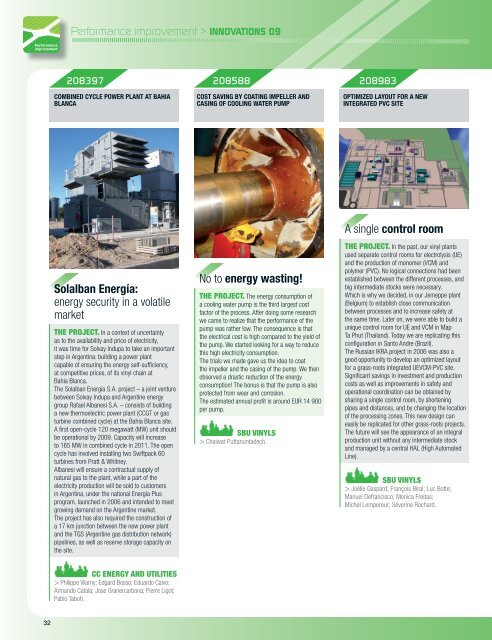

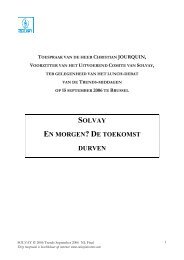
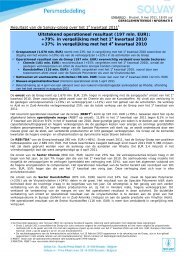

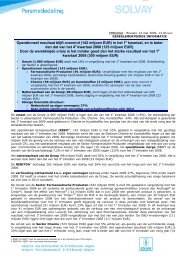



![PROC.1 [LETTRE] - Solvay](https://img.yumpu.com/16585746/1/184x260/proc1-lettre-solvay.jpg?quality=85)
